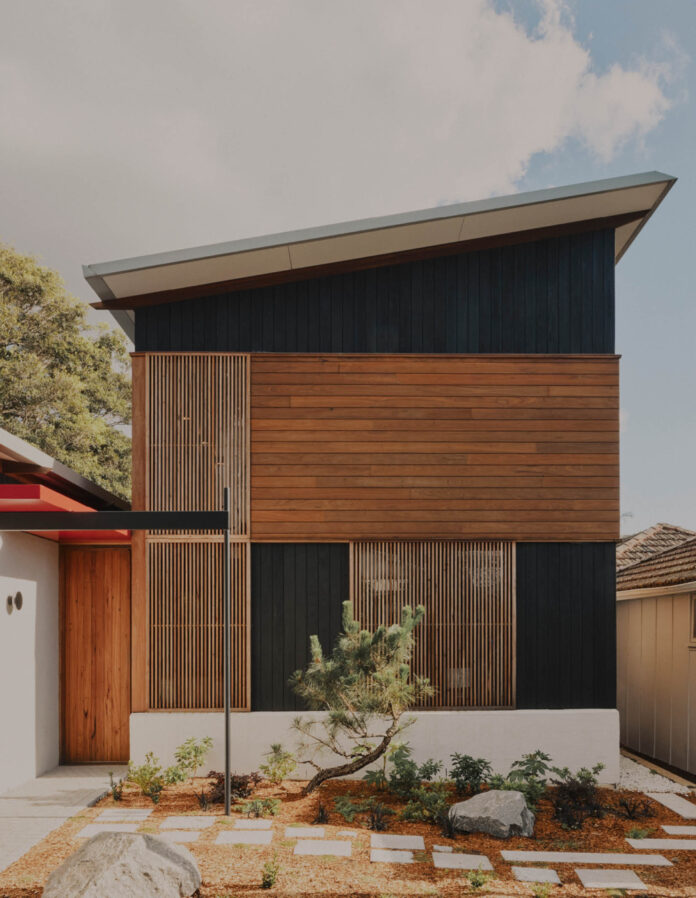[ad_1]
This Accessible NSW Home Beautifully Channels Japanese Architecture
Architecture

Welcome to Butterfly House by Dane Taylor Design. Photo – Daniel Mulheran. Editorial styling – Nicki Colbran

The home sits snug on a narrow block in Austinmer, NSW. Photo – Daniel Mulheran. Editorial styling – Nicki Colbran

Architect Dane Taylor was engaged by his friend and client to create a serene home that could meet her accessible needs. Photo – Daniel Mulheran. Editorial styling – Nicki Colbran

Japanese architecture and wabi-sabi principles influenced the home’s resulting design. Photo – Daniel Mulheran. Editorial styling – Nicki Colbran

Wide, accessible spaces make way for passive design elements and views of the garden. Photo – Daniel Mulheran. Editorial styling – Nicki Colbran

Photo – Daniel Mulheran. Editorial styling – Nicki Colbran

Rammed earth (a low environmental impact material) was used for the chimney breast and as thermal mass. Photo – Daniel Mulheran. Editorial styling – Nicki Colbran

Timber screening also showcases the home’s Japanese influences. Photo – Daniel Mulheran. Editorial styling – Nicki Colbran

‘I wanted to create tranquil spaces with a warm material palette, and a sustainable, hand-crafted home that embraced its natural surroundings, with the ability to settle into the landscape almost instantly,’ Dane explains. Photo – Daniel Mulheran. Editorial styling – Nicki Colbran

Recycled timber was used throughout the home. Photo – Daniel Mulheran. Editorial styling – Nicki Colbran

Photo – Daniel Mulheran. Editorial styling – Nicki Colbran

Owner Helen says the house is ‘very different from the western style housing I have lived in all my life’. Photo – Daniel Mulheran. Editorial styling – Nicki Colbran

‘Increasingly friends understand that the genkan (entrance) functions as a place to remove your shoes and change into slippers. As a disabled person, I find many of these design elements respect the house’s integrity, access and the importance of cleanliness,’ Helen adds. Photo – Daniel Mulheran. Editorial styling – Nicki Colbran

The serene bedroom. Photo – Daniel Mulheran. Editorial styling – Nicki Colbran

‘Few can enjoy the uniqueness of Japanese-inspired architecture in Australia,’ Helen says. Photo – Daniel Mulheran. Editorial styling – Nicki Colbran
Architect Dane Taylor met his now-friend and client Helen Meekosha at his local café about 10 years ago in Austinmer, NSW, where she had owned a holiday home on a double block for years.
‘Helen, who is a university professor and has MS, requires a wheelchair and needed a lift to Sydney, where she lived at the time,’ Dane says. ‘I offered to help as I was heading that way shortly.’
The two bonded over all-things music, art, travel, and architecture on the hour-and-a-half road trip. They kept in touch, and years later when it came time for Helen to migrate to Austinmer permanently, she asked Dane to design the property. As the project progressed, Dane invited Hans Freymadl to collaborate on the home’s design.
‘As Helen had spent years in Sydney city living with chronic illness, our vision was for this house to be her permanent coastal retreat for refuge and recovery,’ Dane explains.
The design was underpinned by the simplicity and minimalist approach of contemporary Japanese architecture. Existing Illawarra gumtrees were enhanced by a tranquil Zen-style garden, located beyond sliding doors that lead to an ‘engawa’ – a timber Japanese-style deck. The Wabi-Sabi philosophy, in its acceptance of the imperfect and adaptability to change, was another key influence on the home.
These ideas come to life within the home’s warm material palette. Windows and doors were made from recycled hardwoods, while passive solar design principles and sustainable features like a 5kw solar system, rainwater harvesting, natural ventilation were all carefully integrated.
‘I love embracing the imperfections [of recycled timber],’ Dane says – something which is very aligned with wabi-sabi’s approach to appreciating beauty that is imperfect, impermanent, and incomplete in nature. ‘This “imperfect” materiality can also be seen in the rammed earth chimney breast and the Shou sugi ban cladding boards with their burnt finish.’
Dane says the resulting aesthetic is also a nod to mid-century modernism, expressed in the home’s asymmetric and flat roof lines.
But the floorplan was something that had to be carefully considered to meet Helen’s needs. The home is wheelchair accessible, which required gentle grades and wider, more generous circulation spaces and openings – ‘something I find quite lovely in architecture’, Dane adds.
‘These features, I feel, actually add to the uniqueness of the project’ Dane continues. ‘This speaks to the old adage that often constraints can lead to innovative, bespoke design outcomes.’
[ad_2]
thedesignfiles.net










